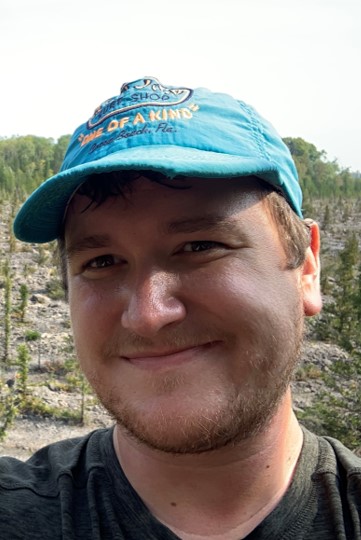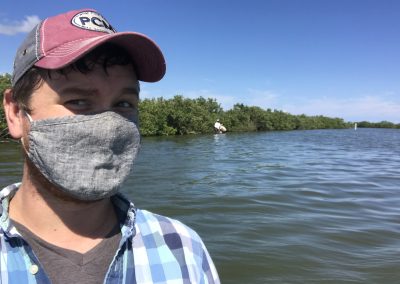David Cannon
Assistant Research ScientistResearcher Profile:
David completed his PhD in Civil Engineering at Purdue University, where he studied physical limnology and biophysical interactions in Lake Michigan. At CIGLR, David’s work is focused on operational model development (i.e. GLOFS; next-gen MOM6) and lake-climate modeling and observations. He is especially interested in how lake temperatures, ice cover, and mixing are changing in the Great Lakes, and how these changes are being propagated through downstream ecosystem processes.
Education:
-
- Ph.D., Civil Engineering, Purdue University (2019)
- M.S., Civil Engineering, Purdue University (2016)
- B.S., Civil Engineering, Purdue University (2014)
Research Interest/Area of Expertise:
-
- Physical Limnology
- Ecohydraulics
- Operational Model Development
- Climate Variability
Recent Publications:
Javaherian, M.J., Cannon, D., Wang, J., Fujisaki-Manome, A., Bai, P., Zuo, L. (2025). Simulating ice-wave interactions in the Laurentian Great Lakes using a fully coupled hydrodynamic-ice-wave model. Ocean Modelling. 102513. (DOI:10.1016/j.ocemod.2025.102513).
Cannon, D., Wang, J., Fujisaki-Manome, A., Kessler, J., Ruberg, S., & Constant, S. (2024). Investigating multidecadal trends in ice cover and subsurface temperatures in the laurentian great lakes using a coupled hydrodynamic–ice model. Journal of Climate. 37(4), 1249-1276. (DOI:10.1175/JCLI-D-23-0092.1). [Altmeric Score]
Cannon, D., Kibler, K., Walters, L., & Chambers, L. (2022). Hydrodynamic and biogeochemical evolution of a restored intertidal oyster (Crassostrea virginica) reef. Science of The Total Environment. 831, 154879. (DOI:10.1016/j.scitotenv.2022.154879). [Altmeric Score]
Presentations
Cannon, D., K. Kibler, V. Kitsikoudis, L. Walters, S. Medeiros (2021) Canopy-flow interactions in Mosquito Lagoon: A review of recent work on eastern oyster (Crassostrea virginica) reefs and shallow shoal grass (Halodule wrightii) fringes. Indian River Lagoon Symposium, Online. February 18-19, 2021.
Cannon, D., K. Kibler, V. Kitsikoudis, S. Medeiros, L. Walters (2020) The effects of oyster reef restoration on flow and turbulence characteristics in a microtidal estuary. American Geophysical Union Fall Meeting, Online. December 1-17, 2020.
Cannon, D., C. Troy, H. Bootsma, Q. Liao, R. MacLellan-Hurd, T. Jin (2019) Ice-free radiative convection in the Laurentian Great Lakes. Invited Speaker: École Polytechnique fédérale de Lausanne, Lausanne, Switzerland. June 18, 2019.
Cannon, D., C. Troy, H. Bootsma, Q. Liao, R. MacLellan-Hurd, T. Jin (2019) Observations of ice-free radiative convection and turbulent mixing in Lake Michigan. International Association of Great Lakes Research Conference, Brockport, NY. June 10-15, 2019.
Cannon, D., C. Troy (2019) Physical Processes in the Great Lakes. Invited Speaker. Department of Forestry and Natural Resources, Purdue University, IN. Spring, 2019.
Cannon, D., C. Troy, H. Bootsma, Q. Liao, R. MacLellan-Hurd, T. Jin (2018) Observations of hypolimnetic turbulence in Lake Michigan and implications for mussel filtration. International Association of Great Lakes Research Conference, Toronto, ON, Canada. June 18-22, 2018.
Cannon, D., C. Troy, H. Bootsma, Q. Liao, R. MacLellan-Hurd, T. Jin (2017) Regulation of plankton and nutrient dynamics by hydrodynamics and profundal filter feeders. State of Lake Michigan Conference, Green Bay, WI, November 7-10, 2017.
Cannon, D., C. Troy (2017) Examining the importance of stratification and unsteadiness in law-of-the-wall velocity scaling. International Association of Great Lakes Research Conference, Detroit, MI, May 15-19, 2017.
Cannon, D., C. Troy (2016). Near-bottom turbulence in the deep hypolimnetic waters of a large stratified basin. Ocean Sciences Meeting, New Orleans, LA, February 24, 2016.




